
Seizure in the piston pin bosses
Information on diagnostics
How can damage occur in the piston pin bores? Why should you lubricate the piston pin beds when installing the pistons? Why does the piston pin have a blue coating around the conrod bush? What are the most common causes of seizures in the piston pin bosses? You can find all the key information in this article.
General information about seizure in the piston pin bosses
The piston pin boss is not forcibly supplied with oil. Only splash oil or centrifugal oil is available. As a result, seizures on the piston pin bed are nearly always seizures due to lack of lubrication, with severely torn-up surfaces and fusion of
materials.
On floating-fit piston pins, damage to the piston pin bores primarily arises:
- if the piston pin has insufficient clearance in the connecting rod bush.
- if the piston pin seizes or jams in the connecting rod bush.
This is indicated by piston pins with blue tempering colours around the connecting rod bush. If the freedom of movement of the piston pin is restricted in the connecting rod bush, the pin is forced to rotate in the piston pin boss. However, the clearance of a floating-fit piston pin in the piston pin bores is too small for this. Extreme build-up of heat, the collapse of the lubrication system and seizures due to lack of lubrication in the piston pin boss will occur as a result.
Due to the high temperature increase, the piston also expands a great deal more on the skirt in the area of the piston pin bores. There, this can lead to a lack of clearances as well as seizures due to lack of lubrication in the cylinder bore (refer to the chapter entitled “45° seizure marks”).
For piston pins that are shrunk into the connecting rod, the clearance in the piston pin bore is sufficiently dimensioned to ensure that an adequate oil film can form there. When reusing used shrink-fit connecting rods it is important to ensure that the bore in the connecting rod has not become distorted or damaged in any other way. Otherwise, once the piston pin has been shrunk in place it could become deformed to such an extent that the clearance in the piston pin bores is no longer sufficient, as a result of which slight seizure marks could form. Always lubricate the piston pin bed when installing the pistons to ensure that enough lubricant is provided for the first few revolutions.
NOTE
 |
During the process of shrinking the piston pin into the connecting rod, the abovementioned lubrication of the piston pin is not the only aspect to consider. Immediately after the piston pin is inserted, the piston pin bed must not be checked for freedom of movement by tilting the piston back and forth! This is because the temperatures are equalized between the two components in this phase (cool piston pin, hot connecting rod). The piston pin can become very hot; it expands significantly and seizes in the piston pin boss. If the bed is moved in this state, it can cause initial rubbing marks or seizure marks. This may cause subsequent stiffness of the bed and thus increased friction and heat generation. For this reason always allow the assembled components to cool down first before checking the bed for freedom of movement. |
Seizure in the piston pin bosses (floating-fit piston pin)
- Piston pin has seized in the piston pin bores.
- Piston material has been welded onto the piston pin (Fig. 1).
- Piston pin displays a blue discolouration in the area of the connecting rod bush.
Damage assessment
The blue discolouration of the piston pin in the area of the connecting rod bush indicates that the clearance there was insufficient, and that as a result the piston pin was only able to rotate in the connecting rod bush with difficulty or not at all. The only rotation of the piston pin took place in the piston pin bore. However, the clearance of a floating-fit piston pin is too small for this. The increased friction caused overheating in the bearing, as a result of which the oil film became ineffective and the piston pin seizure arose.
Possible causes for the damage
- The clearance between the connecting rod bush and the piston pin was not made large enough.
- The clearance in the connecting rod bush was bridged by a misalignment of the connecting rod and the piston pin became seized as a result.
- The piston pin bed was not lubricated when the pistons were installed.
NOTE
 |
It is essential to generously lubricate the piston pin bed when installing the pistons to ensure that sufficient lubrication is present during the first few revolutions of the engine and to prevent initial rubbing marks from being formed when the engine is started. |
Seizure in the piston pin bosses (shrink-fit connecting rod)
- Piston has only run for a short length of time.
- No wear marks on the piston skirt.
- The piston pin bosses have seized on the upper side, i.e. the side under pressure load (Fig. 1).
- The surface at the seizures is clean bare metal; no traces of burned-in oil.
Damage assessment
The piston has barely any wear marks and can therefore only have been run for a short time. The piston pin already seized during the first revolutions of the engine. The clean bare metal seizures are a clear indication of a lack of oil in the piston pin bed.
Possible causes for the damage
- Piston pin bed was not lubricated before the piston was installed.
- When shrink-fitting the piston pin into the connecting rod, the freedom of movement of the piston pin bed was checked immediately after inserting the piston pin by tilting the piston back and forth. The bed can suffer at this point as a result of the unusual temperature differences between the components that do not occur in normal operation.
Seizure in the piston pin bosses (with piston skirt seizure)
- Piston skirt has seized on both sides, starting at the piston head.
- Compression rings have become blocked in the ring grooves.
- Seizure marks are present in the piston pin bosses.
Damage assessment
The focus of the seizures on the piston head indicates that this is where the damage originated as a result of abnormal combustion. Subsequently the piston rings seized up, and the seizure marks spread increasingly down onto the skirt area. The combustion gases streamed past the seized compression rings and heated up the piston to such a point that the oil film in the piston pin bed became ineffective, and seizures developed here as well.
Possible causes for the damage
Abnormal combustion leads to a seizure due to the combined effects of insufficient clearance and lack of lubrication on the piston head and piston skirt and subsequently also causes seizures in the piston pin bed.

